Archive for ‘Office Supplies’ Category
Is Your Junk Drawer a Drunk Drawer? 3 Steps to An Organized Junk Drawer
[This post originally appeared on January 8, 2019, and has been updated with additional material as of October 4, 2021.]
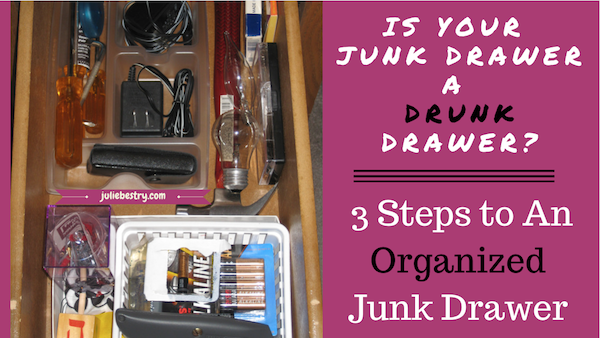
One of my clients refers to her kitchen junk drawer the “Drunk Drawer.”
I don’t drink, so I thought I was missing a pop culture reference. She said that now that we’ve been working together to help her get her life back in order after a few tumultuous years, most of her life is planned out to the nearest detail — organized, categorized, contained. But, on the rare occasion that someone puts a margarita in her hand, especially after a stressful time at work, and she has the opportunity to let her hair down, everything flows freely.
My client notes that with a margarita (or a few) in hand, she says what she wants, she dances to her own drummer, and she gives herself permission to accept that not everything makes sense. Similarly, my client sees that her junk drawer is the one area in her house where she lets the wackiness take over, categories intermingle, and nothing makes sense.
I was reminded of my client’s story when I was approached by Katina Hazimihalis of Dumpsters.com for the Start Fresh: Take the 30-day Decluttering Challenge. (Definitely check it out!) They asked for my advice for Day 7, earmarked as the day of their challenge to “Declutter the Kitchen Junk Drawer.”
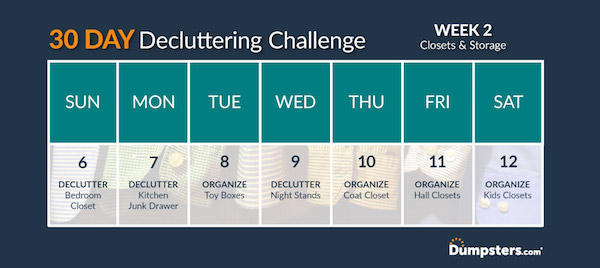 Longtime readers of Paper Doll know that I can never give only a little bit of advice, so there’s a lot that didn’t make it into that post. So, now it’s all here for you!
Longtime readers of Paper Doll know that I can never give only a little bit of advice, so there’s a lot that didn’t make it into that post. So, now it’s all here for you!
WHAT’S THE DEAL WITH THE JUNK DRAWER?
Most of the things in a junk drawer aren’t junk. They just tend to be far from their friends in similar categories — the loose change that never makes it to the wallet, the tools that haven’t found their way back to the toolbox, all those random things we want to keep, but we don’t want to take the time to think about where they belong.
Seth Godin says, “The junk drawer is the enemy of understanding.” I have to agree. If you can’t name it, you can’t fathom it.
With paper, “miscellaneous” is the enemy. Is it financial, legal, medical, household, or personal? Is it action paper or reference paper?
With clothing, it’s either underwear, outerwear, or what you wear! You can subdivide into shirts, pants, dresses, etc., and onward to sleeve length or color or season, but there’s still a basic way to start breaking things down.
Categorically, things need to belong somewhere — is it fish or fowl? Animal, vegetable, or mineral? Ginger or Mary Ann? If you can name it, you can put it into place.
Something has to belong somewhere — is it fish or fowl? Animal, vegetable, or mineral? Ginger or Mary Ann? If you can name it, you can put it into place. Share on XBut unlike paper or clothing, not everything has just one home. Some things have a main home and a vacation home — that’s the junk drawer. Yes, you should have a home first aid kit, but it’s helpful to keep a few Band-aids in the kitchen. Yes, most of your office supplies belong in your home office or at your desk, but sometimes you need to grab a highlighter to make sense of the recipe you’re making.
At its best, the household junk drawer can be a miniature subset of categories found around the house. At its worse, however, it’s drunk. It’s sloppy, it makes no sense, and it leads you down a path of regret. Let’s fix that!
WHAT’S THE FIRST STEP TO ORGANIZING A JUNK DRAWER?
Empty that junk drawer. Dump the whole thing out.
It’s rare to hear a professional organizer advise emptying everything out of any space. Usually, we focus on handling one shelf or one category at a time. That’s because the last thing you want to do is get ninety minutes into a closet overhaul and have to pick up your children from school, leaving you with an unusable bedroom and a huge headache.
However, there are two reasons why a complete dump-out makes sense with a drunk junk drawer. First, junk drawers are small. Other than a wallet, purse, or glove compartment, I’d be hard-pressed to find a smaller space that requires concerted attention.
Second, approaching a junk drawer too delicately usually means nothing ever gets completed. People pull out one item at a time and make a few decisions, put a few things back when they decide to keep them, and never quite get around to making decisions about everything. Instead, the best thing to do is to remove everything from the drawer.
Because most junk drawers are in kitchens, what often works is to put a large towel down on the countertop or kitchen table (to prevent scratches). Plop everything down together. Slowly move things to the outer edges of the towel, as if you were searching for a Canadian penny amid all the coins you’ve shaken out of your piggy bank.
Grab the low-hanging fruit first. Remove gum, candy, soy sauce or hot sauce packets, or really anything edible and move to a “snack” box or food storage container on one of the shelves of your kitchen or pantry. Keep sticky, melty, or bug-friendly edibles out of the junk drawer.
Select one item at a time and ask yourself a few questions:
- Is it broken, expired, dried out (like pens or old wipes), or icky? Toss it out!
- Do you ever really use it? If not, you might toss it or donate it.
- Do you find yourself using it often enough that it really needs to be in the kitchen (or whatever room you keep your junk drawer)? If not, move it to a part of the house where it better fits with a category of items already kept elsewhere, like tools or office supplies.
- Do you need this many of whatever it is? Keep your favorite, keep the best, keep the one you’d grab if you needed it. Set the excess free (from the drawer) and either donate or move to a more appropriate place in your home.
Remember, if you don’t use it often, don’t let it take up the valuable prime real estate in your drawer!
NEXT, MAKE SENSE OUT OF THE CATEGORIES
At first glance, it may seem like everything in the junk drawer belongs to the miscellaneous category, but with patience, you’ll start seeing patterns.
Categorize the items into little areas/zones on the counter or table so you get a sense of how many of each thing you have. If you have duplicates, triplicates, or more, you may want to keep one version handy in the drawer, but move the remainder elsewhere, in your own mini-mall of “when I need them” supplies.
Ask yourself, what does the item DO? What is it for? Some category examples:
Batteries — Keep a small supply of the most commonly (and urgently) needed (like AA and AAA). Move the rest, plus whatever other sizes (9 volt, C and D, and smaller batteries for hearing aids, watches, and medical devices) to one divided container (like a tackle box) elsewhere in the house, like in a cabinet or on a shelf in the laundry room, utility room, or basement.
Duplicate keys — Use key cap tags/covers or labels to identify what the keys fit and keep all keys in one container.
NAPO2018: Paper Doll Explores Meori & the Glorious Goodies Within

In the last few posts, I explained that this year’s NAPO2018 was billed as a retreat instead of a conference and expo, and without an expo, I feared that I’d have no bounty of new products to share with you. However, thanks to our sponsors, even without an expo, I still have some goodies to present.
MEORI
At our welcome event, all conference attendees received a Meori foldable box absolutely filled to the brim with goodies. Mine was this Lava-Black-with-White-Flowers version, but Meori (a product I’d planned to profile this spring anyway), comes in a variety of gorgeous patterns and colors. That said, I couldn’t convince any of my colleagues to trade me this one for a Paper Doll-themed Midnight Magenta Meori box.
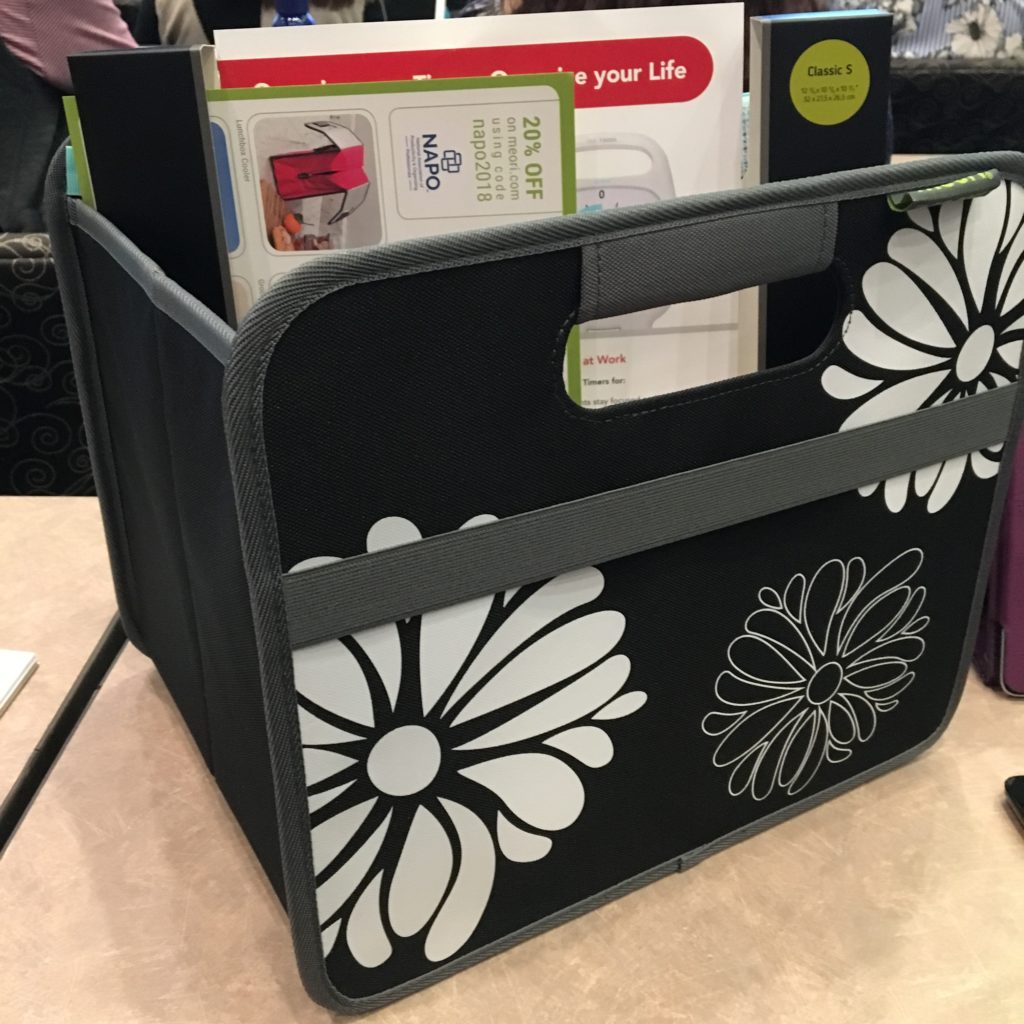
The Meori foldable boxes are made from high-grade, tear-proof, dirt-resistant polyester that you can wipe clean with a damp sponge. Did you know that the German word for “dirt-resistant” is schmutzabweisend? Boy, Meori’s packaging is educational!
All varieties fold or unfold in three easy steps to become a completely stable (but decorative) storage box secured with a wide elastic band. With the exception of the Mini, all styles hold up to 65 pounds! (Paper Doll does not advise having so much stuff in your Meori box that it turns into clutter you must cart around, but it’s nice to know that Meori is sturdy!)
The Classic Meori comes in four sizes and all have elastic mesh interior pockets.
Mini – The mini measures 5″ L x 6 1/2″ W x 5″ D, and is perfect for organizing teeny things in a bathroom, dorm room, school locker or car. The Minis come in Hibiscus Red (pictured below), Azure Blue, Marine Blue, Pink Berry, and Spring Green. ($12.99)
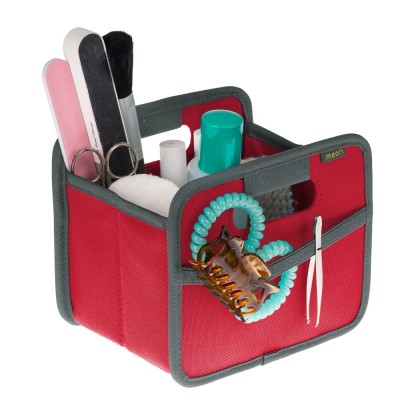
You can also purchase a shiny silver-finish wall mount for the Mini ($5.99) to keep things accessible on the back of a door or on a wall near where you’re heading out of the house. There’s also a collapsible Meori Mini Hanger in Marine Blue that lets you store three Minis vertically, hung from a velcro loop on the bar of your closet.
- Meori Mini Hanger
- Meori Mini Hanger – collapsed
Small – I was a little shocked to learn that my own Meori (pictured up top) is considered the Classic Small, because it’s fairly mighty. It measures 12 3/5″ L by 10 5/6″ W by 10 3/7″ D, and holds 4 gallons of whatever stuff you throw into it. (If those measurements seem odd, recognize Meori, a Japanese-themed German company, like most of the world, uses the metric system, and 32 x 27.5 x 26.5 cm sounds a bit less unwieldy.) The Small comes in 31 different color/pattern combinations in solids, polka dots, and flowers. ($25)
Medium – The Meori Medium comes in ten color/pattern combinations, with solids or star patterns, and measures 12 3/5″ W x 10 5/6″ H x 14 4/7″ D (again, it makes more sense in the metric system). It’s perfect for carting groceries or other shopping items (up to 6.5 gallons of goods) from cart to car to house and back out again. ($30)

Large – The Classic Large should probably be called the Double-Duty. It comes in 34 different color/pattern combinations, measures 19 3/4″ L x 12 3/4″ W x 10 3/4″ D, and has two interior compartments. It will hold 8 gallons of whatever you’ve got! ($35)
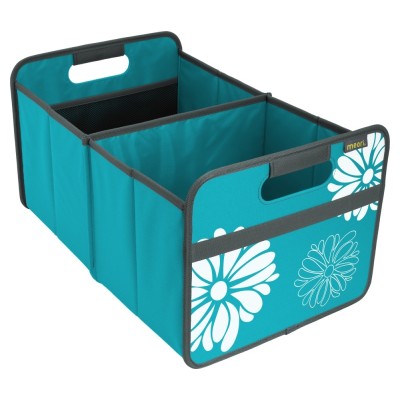
All of the Meori foldable boxes collapse down to between one and two inches thick, making them easy to ship or store when not in use.
Other Meori foldable boxes include:
Office – Measuring 12″ W x 13″ H x 12″ D, suitable for standard letter-sized folders, and able to hold up to 65 pounds, the Office Meori has built-in plastic file rails and a rewritable label. It’s ideal for mobile offices and workers who shuttle between locations, and folds down to 1 1/9″ when not in use. (For European readers, there’s also an Office A4 style.) Unfortunately, it only comes in Lava Black or Solid Grey, which is a shame given the rest of Meori’s bold color palette. ($40)
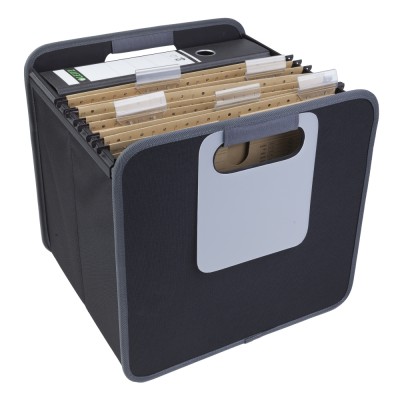
Outdoor – This outdoorsy version of the Meori has the same measurements as the Classic Large, but is made of water-repellent rip-stop fabric. Suitable for camping, sailing, picnics, and other outdoor adventures, it includes snap buttons and 4 metal grommets so you can secure it to a truck bed or tie it up to a boat. The Outdoor can be adjusted to use as two small boxes or one large one. ($42)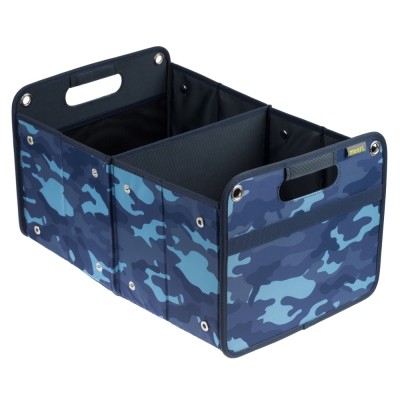
Meori has developed a line of accessories, including a 26″ padded, nylon carrying handle with metal hooks for use with the Small, Medium, and Large Classic foldable boxes, and a 56″ adjustable, nylon shoulder strap for use with the Small, Medium and Large Classic foldable boxes as well as the Office and Outdoor boxes. There are also covers for the Classic and Outdoor versions to protect your contents from rain, sleet, snow, dust – and, if you live in the southeastern US as I do – pollen!
If you’re looking for something to keep up with your snacking habits, Meori has a foldable cooling bag with a zipper that will fit in the Classic Small, Medium, and Large versions, and a tailgate carrier set with the Classic Large and the cooler, combined. The Picnicker fits in the Classic Small, Medium, and Large, and will secure four sets of (nesting) plates, cutlery, drinkware, and a cutting board. If you plan on taking some beverages along, Meori has 9- and 16-compartment expandable, padded bottle inserts.
Intrigued? Check out Meori’s site to find other attractive, durable, collapsible/foldable options, including 2-, 6-, and 12-bottle wine totes/carriers, insulated lunchbox cooler, hobby box, and more.
THE OTHER GOODIES
Our sponsors didn’t leave those Meori boxes empty. Inside, we had a bounty of useful items including:
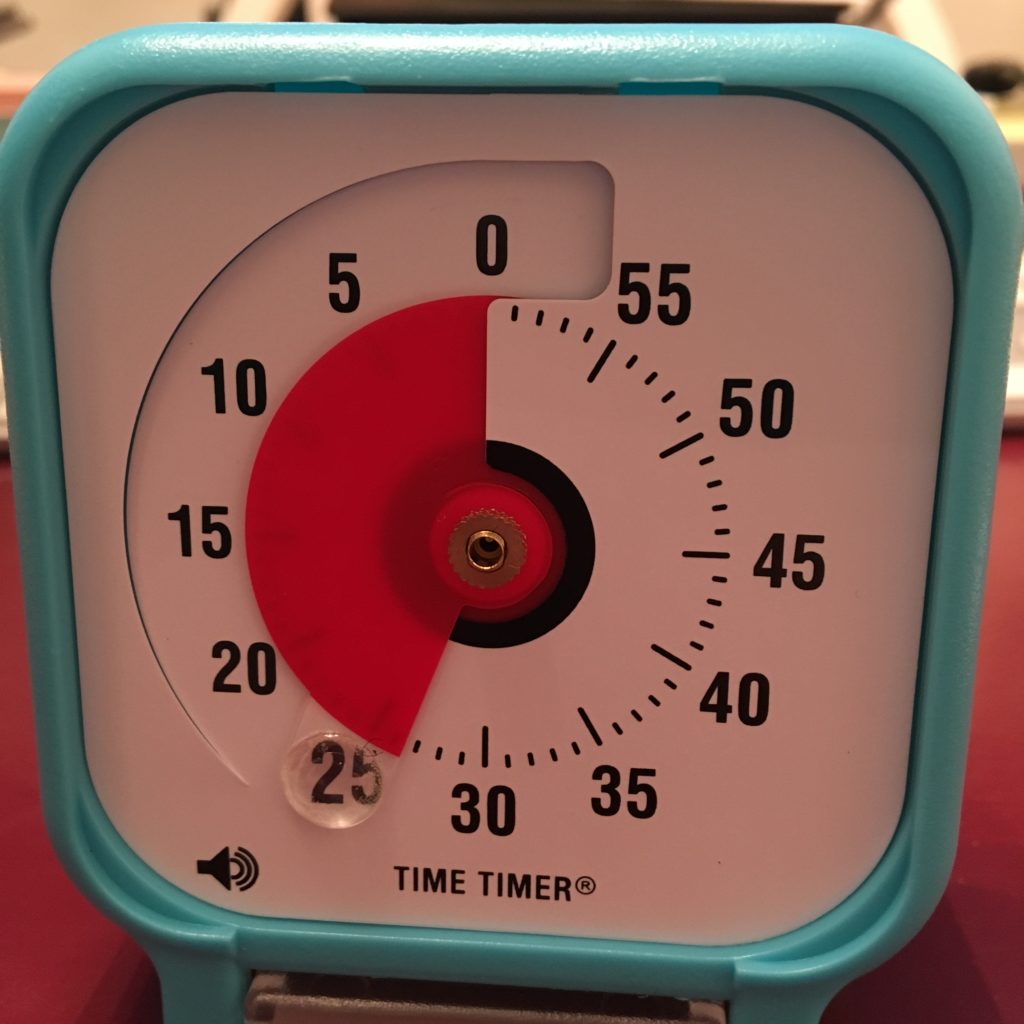
Last year, I wrote Paper Doll’s NAPO 2017 Recap: New Twists on Time Timer and I’ve repeatedly shared all the reasons to love all of the incarnations of Time Timer. My old (circa 2002) Time Timer has certainly been put through its paces over the years, so I’m excited to add this tiny 3-inch powerhouse to my procrastination-fighting arsenal.
Container Store Zippered Pouch
Our friends at Container Store gifted all NAPO2018 attendees a large, zippered pouch. Made of nylon mesh embedded in clear vinyl for reinforcement, it’s weather- and puncture-resistant, and perfect for keeping travel or other documents sorted, clean, and dry. The pretty aqua detailing and zipper add some panache, and I’ve just noticed that it all matches the Time Timer version I got! How very organized!
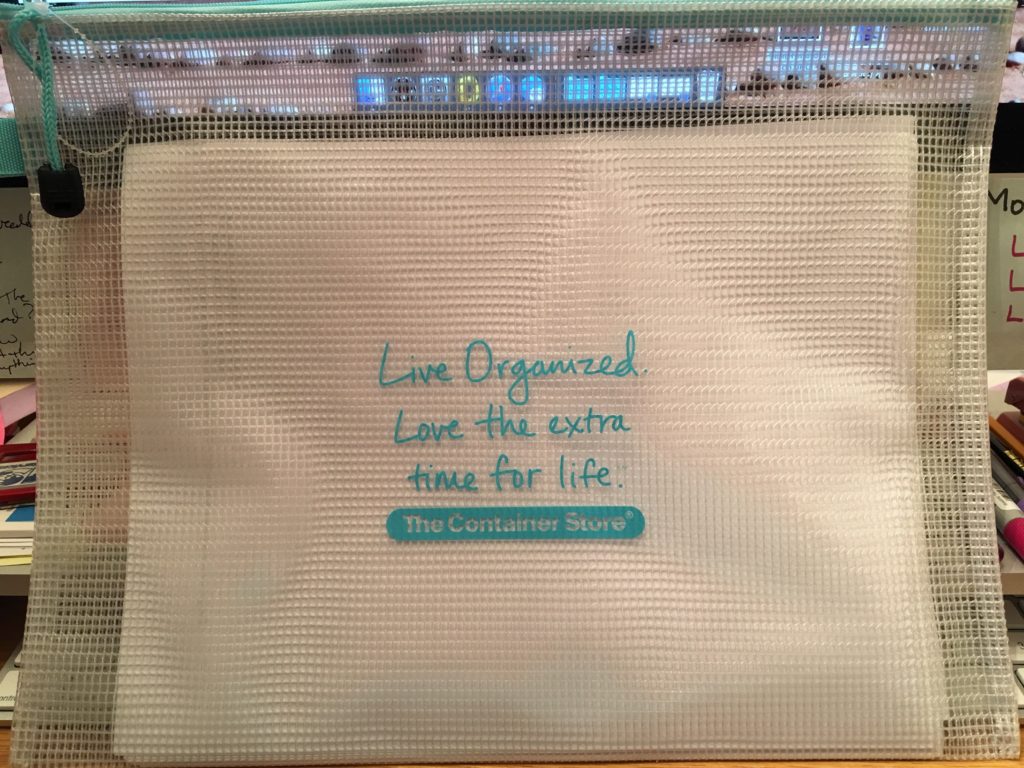
Others of our sponsors made sure we stayed hydrated and healthy. Brother quenched our thirsts by supplying these nifty water bottles we could hang from our pinkies while schlepping across the “campus” between sessions.
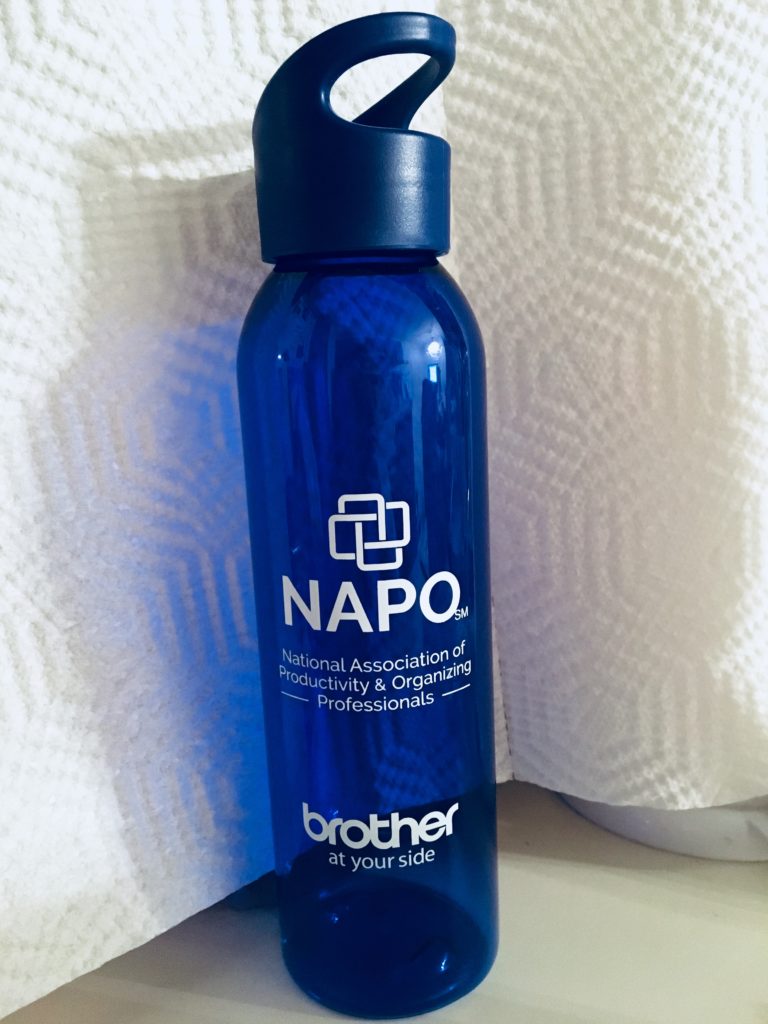
Meanwhile, RXBar, a company that makes “whole food protein bars” in 15 different flavors (using egg whites, dried fruits, nuts, and dates, and just one or two other natural ingredients, provided bars for munching. (I got Blueberry!) And our own Denslow Brown of the Coach Approach for Organizers made sure we had some Emergen-C, just to make sure we didn’t get run down!
BUT WAIT, NO PAPER ORGANIZING PRODUCTS?
Although we did not have an expo this year, our friends at Smead (one of our two major NAPO2018 conference sponsors, along with Brother) knew that I couldn’t survive a NAPO conference without getting to hold organizing supplies in my hand. So, with great foresight, Smead brought our favorite people and some (new) favorite products. Coming up soon, we’ll delve into the newest and niftiest of what Smead had to show us.
Sticky to the Extreme: Organizing Information in Extreme Situations with Post-it® Extreme Notes
Unless you’ve been acting out a real-life Rip Van Winkle scenario for the past four decades, you don’t need anyone to tell you what a Post-it® Note is. In fact, you’re probably already imagining the 3-inch squares with adhesive backing in the traditional bright yellow. Of course, these office supply staples come in gorgeous color varieties and themed color collections with exotic place names – my personal favorite is Marseille, though Bali and Helsinki are soothing, and Miami is so…but I digress.
You can find these original sticky note essentials in sizes ranging from teeny 1 7/8-inch squares to 18 inches by 12 inches (and even as full-sized easel pads), with standard paper or recycled, in regular blocks or tissue-style pop-ups, lined and unlined, square, rectangular, or amusingly shaped. Post-it® even shakes up the adhesive styles – you can get them with regular adhesive, Super-Sticky®, and Full-Stick notes with the whole reverse side able to attach wherever and to whatever.
But never one to rest on its laurels, parent company 3M has decided to take things to extremes.
Post-it® Extreme Notes
You’ve used your favorite stickies for everything from writing down phone numbers to writing To Do lists, from “labeling” paper piles and folders to mapping seating arrangements for weddings. The absolute basic Post-it® Note can handle almost everything you throw at it. But it’s that “almost” that Post-it® has taken as a challenge. I can almost hear the engineers and marketing guys in a room together to ponder what might be possible.
“What if we soaked them?”
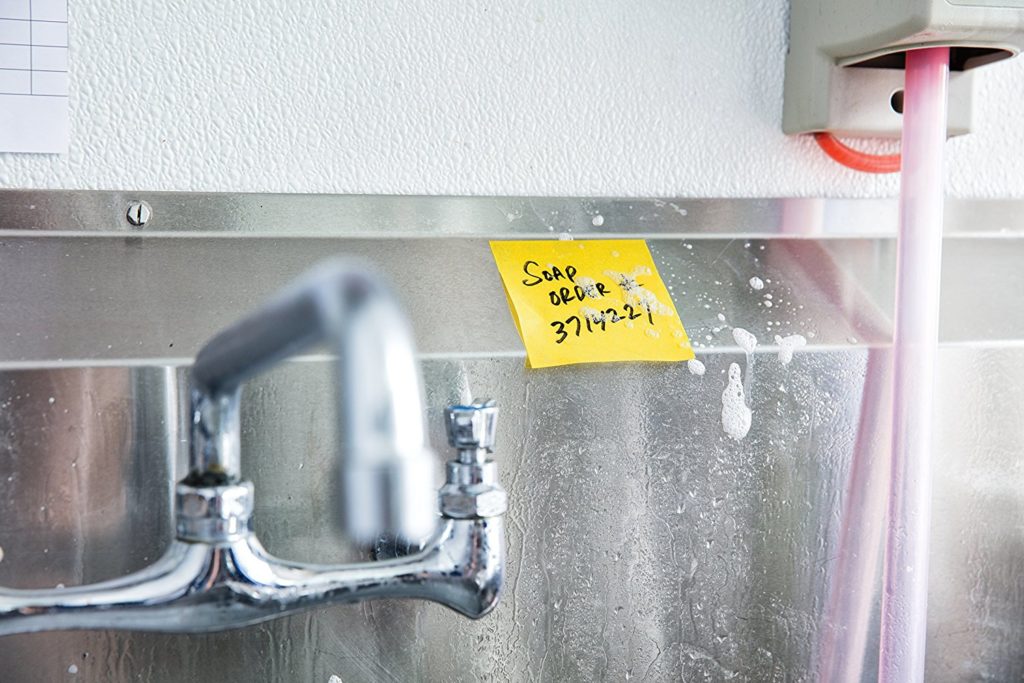
[Maybe they should have studied Paper Doll Writes Between the Raindrops: Waterproof Notebooks for research ideas?]
“What if we froze them?

“What if we tried to stick them to bumpy walls? Heck, what if we tried to stick them to brick?!”

I’m surprised nobody suggested deep-frying them!
Nonetheless, they’ve taken up the gauntlet and produced the sticky notes for the tough gal-and-guy crowd that lives to the extremes.
Post-it® Extreme Notes are made with ultra-strong Dura-Hold™ Paper and Adhesive, giving them some very interesting properties. They’re “writable,” in the company’s words, meaning the special paper doesn’t interfere with the basic purpose – communicating (to yourself or others) – while making what we sometimes consider a white collar product to be pickup-truck tough.
The Extreme Notes:
- Are durable
- Are water-resistant
- Stick to textured surfaces (like brick, rusty metal, uneven wood, construction materials, etc.)
- Stick in both hot and cold environments (meaning they stand up to steam and ice)
- Can be used both inside and outside (from restaurant freezers and steamy kitchens to cars and walls in windy, rainy, gloppy weather)
- Are designed for tough conditions
- Remove cleanly, leaving no residue – just like the traditional notes
See them in action:
The Post-it® Extreme Notes are (at least for now) available only in the traditional 3″ x 3″ size, 45 sheets per pad.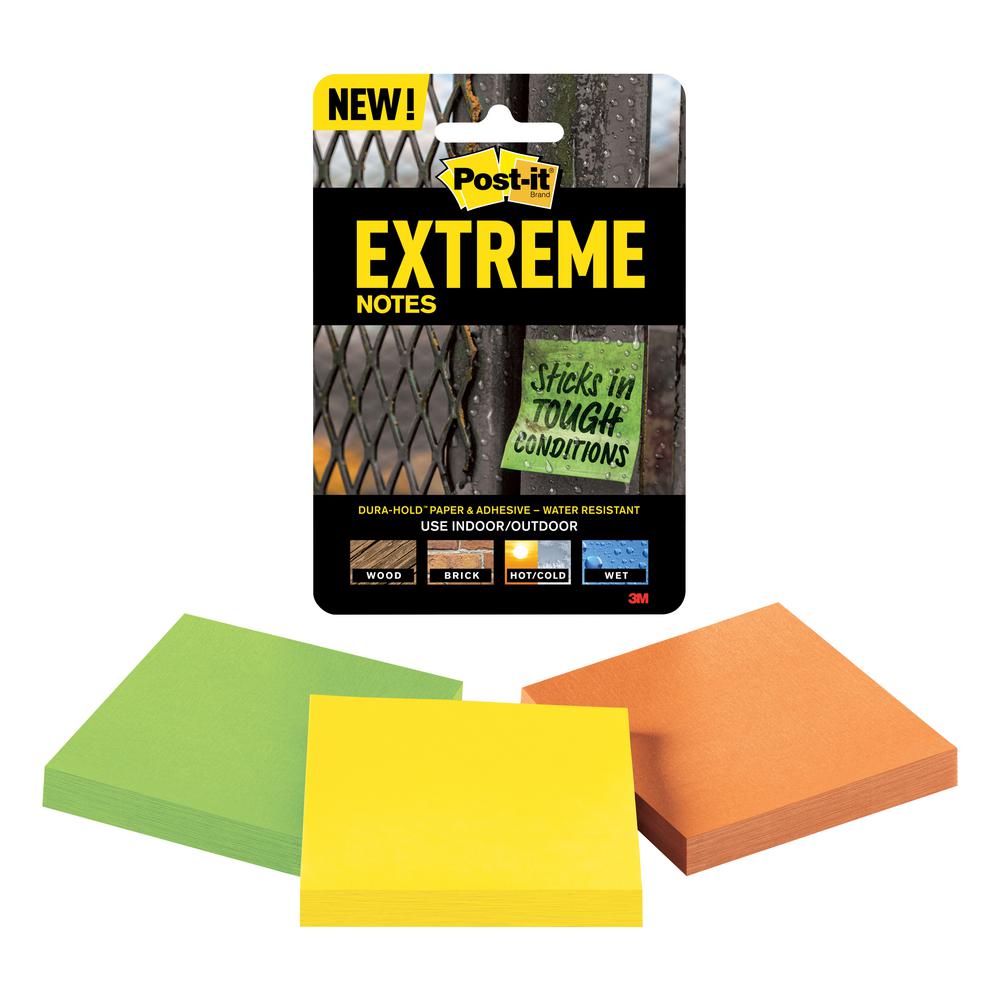 Although they’re made in four colors: orange, green, yellow, and mint, the 3-pad pack (about $5/pack) and 32-pad box varieties come only in the orange/green/yellow assortment or all-green or all-orange. You can also get 12-pad boxes in all-green or all-orange. If you want the mint, you’ll have to buy the Extreme Note 12-pack assortment ($20/pack), as the mint just isn’t available on its own. You can find them at Amazon, Office Depot, Staples, Walmart, Target, and online office supply stores.
Although they’re made in four colors: orange, green, yellow, and mint, the 3-pad pack (about $5/pack) and 32-pad box varieties come only in the orange/green/yellow assortment or all-green or all-orange. You can also get 12-pad boxes in all-green or all-orange. If you want the mint, you’ll have to buy the Extreme Note 12-pack assortment ($20/pack), as the mint just isn’t available on its own. You can find them at Amazon, Office Depot, Staples, Walmart, Target, and online office supply stores.
What’s are the downsides to these tough guys? Nothing too terrible:
- They are not recommended for use on paper.
So, use all of your other pretty sticky notes for those jobs.
- You can’t stick them directly to wet surfaces.
So, if your neighbor’s windshield is covered in frost, don’t write a note complaining that he didn’t shovel the walk and stick it on his frozen, crystalized truck. Instead, apply them to dry surfaces and they’ll keep holding when it gets wet. (In a steamy area? Just wipe the area dry and then stick the note on; even if it’s humid, you’ll get it on there quickly enough.)
- The colors are…not pretty.
I’m sorry, but the orange and green, to my eyes, are downright ugly. The yellow is pretty standard, so there’s nothing to complain about there. The mint, their prettiest color, can only be purchased as one-quarter of a 12-pack assortment! It’s likely that 3M considers this a feature, not a bug – perhaps people in tough environments are conditioned to want to buy tough, un-pretty colors. But I’m betting that there are plenty of lumberjacks and electricians who’d be delighted (even if they wouldn’t use that phrasing) to have some brighter, more uplifting colors.
I have to admit, Paper Doll doesn’t do much in the extreme. No construction zones, no frozen tundra. But I did come up with an idea that might work for me. Sometimes, when I’m about to do a television appearance or speaking engagement, I’m having trouble remembering everything I want to say. But if I can write key phrases on Post-it® Extreme Notes and stick them on the far wall of my shower (completely opposite the showerhead), I can rehearse while I lather, rinse, and repeat.
How might you see yourself using these Post-it® Extreme Notes? Please share in the comments.
Justick by Smead: Vertical Organizing Powered By Balloon Magic
Remember the first time you ever saw someone rub a balloon on his head and then stick the balloon to the wall? You were perhaps four or five years old, and it probably seemed like magic. At some point you learned it was static electricity, but if you’re being honest, doesn’t it still seem like magic?
Well, Smead’s newest answer to solving paper clutter with vertical storage pretty much runs on balloon magic.
JUSTICK BY SMEAD ELECTRO BULLETIN BOARDS
Last year, at the NAPO2016 conference in Atlanta, we got a sneak preview of the Justick by Smead collection, but this year in Pittsburgh, we got our official introduction to their new display boards. We viewed a desktop copyholder, the kind of item you’d usually use for displaying documents to give you easy access while typing at your computer. But look more closely at the Justick — and take a moment to appreciate the adorable tot on the left, the daughter of Smead’s Associate Marketing Manager Leiann Thompson. (Paper Doll is sending a shout-out to Leiann, soon to welcome tot #2 into the world!)
 Can you tell that there’s nothing holding the photos to the copyholder? The photos and doodads adhere to the Justick as if by magic. Rather than needing push-pins, glue, magnets, tape, or that sticky roly-poly stuff used to hang posters, Smead has developed an advanced type of bulletin board that allows you to organize things vertically — using nothing but the power of static electricity!
Can you tell that there’s nothing holding the photos to the copyholder? The photos and doodads adhere to the Justick as if by magic. Rather than needing push-pins, glue, magnets, tape, or that sticky roly-poly stuff used to hang posters, Smead has developed an advanced type of bulletin board that allows you to organize things vertically — using nothing but the power of static electricity!
OK, officially, it’s electro-adhesion surface technology.
Justick’s technology keeps in place whatever you put on the board: photos, memorabilia, reminder notices, business cards, phone lists, illustrations, training material, etc., and does so vertically. And no, you don’t have to rub anything on your head to get it to stick.
The electrical energy behind the Justick boards is powered by four AA batteries, or you can use an optional AC adapter if you’d rather keep it plugged in. Justick products have modern aluminum frames and frameless styles, and there are a variety of display solutions within three main categories:
- Electro Bulletin Boards
- Dry-Erase Boards with Clear Overlays
- Commercial Communication Solutions
Justick Frameless Wall Strip Display
Start by hanging this simple, black, unobtrusive, 48″ W x 8″ H strip on your wall.
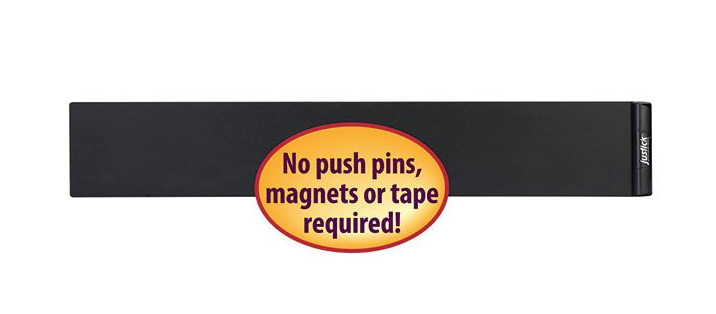
Next, grab anything you’d like to keep in front of your face, but off of your desk. Your toddler’s newest artwork? Up it goes. The business cards for the people you need to call this week? Display them in columns or rows. Birthday cards? Motivational photos of yoga positions? Whatever you’d like to see on your wall, without having to find studs, poke holes, or make anything sticky.

The Justick Frameless Wall Strip Display retails for $79.99 on Amazon, myOrganized.life and Office Depot.
Justick Frameless Desktop Organizer/Copyholder
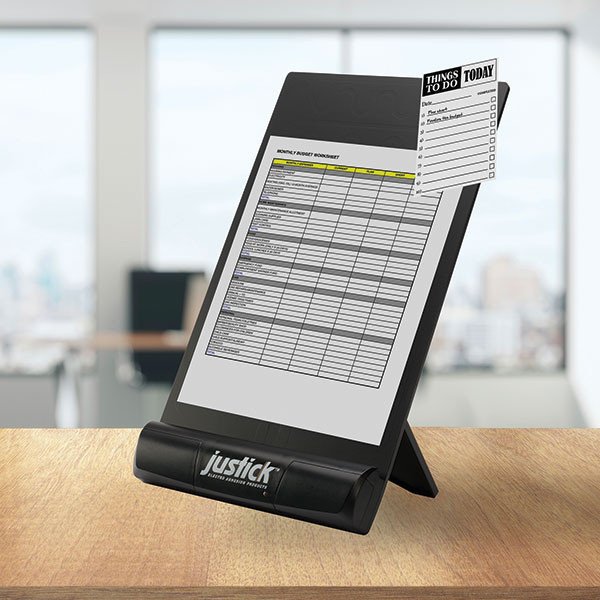
Ever since the days of the typing pool, there has been a need to stand papers vertically while doing your typing. Invariably someone gives you a printout or handwritten document when you’d prefer an email or link to Evernote, and it’s up to you to get the information into digital form. Arraying a document vertically makes it easier to move your eye from the paper to the screen and back again vs. having to keep looking down at your desk.
The neato-keen thing about the Justick version is that you can stick multiple items on at once — so you can keep multiple ad hoc (documents, contracts, to-do lists, etc.) items and more permanent ones (cheat sheets, department codes, etc.) on the same page. Paper Doll tested this out — things really do stick where you put them and, unlike balloon-style static electric power, they do not start sliding down to the floor or desk as time goes on.
The Frameless Desktop Organizer/Copyholder is black, measures 8″ W x 11″ H and is priced at $34.99 at Amazon, myOrganized.life, and Office Depot.
Justick Frameless Mini Electro Bulletin Board
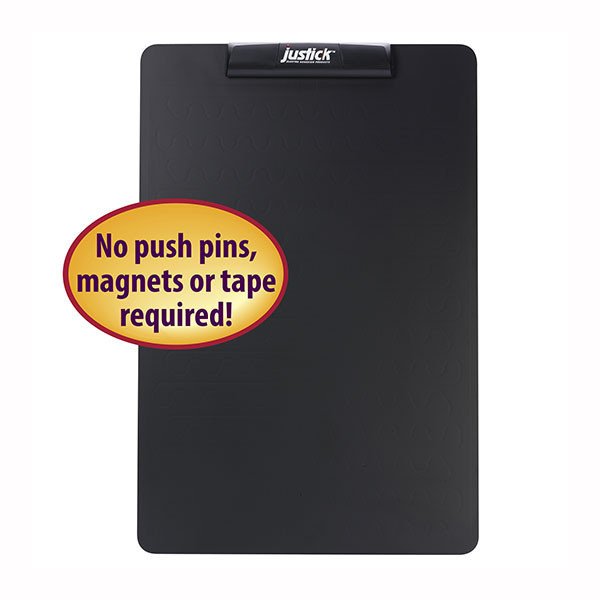
The “mini” bulletin board measures 16″ W x 24″ H, so it isn’t all that small except in comparison to its siblings, but it’s perfect for vertically displaying essential papers in homes and small offices.
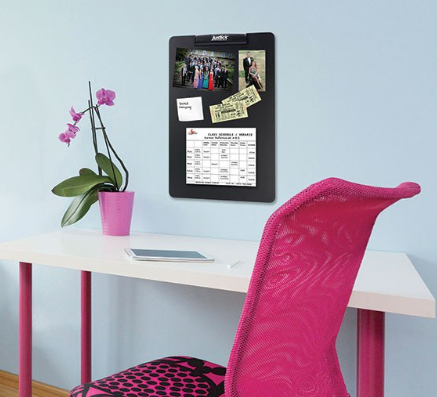
The mini runs $69.99 at myOrganized.life and Amazon.
Justick also has three versions of their framed full-sized electro bulletin boards. The boards for all have modern black styling, and both the standard and premium framed versions are three feet wide by two feet high, suitable for larger home offices and small businesses. The larger premium version, four feet wide by three feet high, is more suitable for larger businesses with ample display space.
- Standard Aluminum Frame Electro Bulletin Board, 36″ W x 24″ H ($79.99 at myOrganized.life or Amazon)
- Premium Aluminum Frame Electro Bulletin Board Black, 36″ W x 24″ H ($119.99 at myOrganized.life or Amazon)

- Premium Aluminum Frame Electro Bulletin Board, 48″ W x 36″ H ($189.99 at Amazon or myOrganized.life), more suitable for office displays.
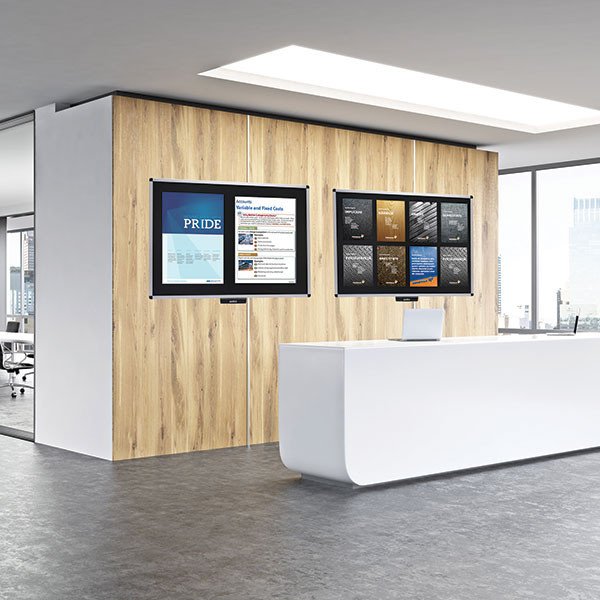
JUSTICK ELECTRO DRY-ERASE BOARDS WITH CLEAR OVERLAY
As discussed above, Justick provides an innovative alternative to a fussy French board in your home or corkboard in your office. But what about when you want a dry-erase board? Do you have wall space enough for both? Happily, you don’t need it, as Justick has also developed a combination electro-board with a clear dry-erase overlay, to serve both purposes.
As with the electro boards above, just install four AA batteries into the board, and the Justick electro surface technology transforms the surface from “zero adhesion” (that is, like any old “dumb wall”) into a powerful force field able to attract photos, papers, business cards, calendars, and memorabilia.
Use either dry-erase or wet-erase markers on your board to “write, display, and interact” with three times the benefit of a traditional board. The durable plastic overlay provides a clear, brilliant surface that Smead says won’t ghost or stain, creating a dynamic whiteboard experience with the utility of a bulletin board. However, as they say on the infomercials…
BUT WAIT, THERE’S MORE!
Smead has also developed Justick overlay board templates. Categories include:
- Education (for teaching addition, alphabet tracing, telling time, cursive writing, and more)
- Sports and Coaching (for teaching basketball, football, and hockey plays)
- Family Activities (daily calendar for activities)
- Home Management (grocery shopping planners, architectural design planning)
- Scheduling and Management (Gantt charts, goal tracking, sales reporting, weekly/monthly/yearly and project planners, and more)
- Medical Industry (hospital and clinic sign in/out, operating room schedules, patient information data for hospital rooms, etc.)
- Restaurant Management Industry (layouts for the day’s specials)
Got papers? Stick them up!
Got something you want to write or draw? Doodle it freehand or use a template! Get thee to it!
Whether you’re doing a presentation for your biggest client or teaching your child that “M” is for “Mommy” by moving a photo of yourself next to where you’re practicing the alphabet together, Justick has an option.
Justick Frameless Mini Dry-Erase Board with Clear Overlay
The Frameless Mini Dry-Erase Board comes in two versions, black or white, with a clear overlay. Both measure 16″ W x 24″ H and sell for $79.99 at Amazon and myOrganized.life.
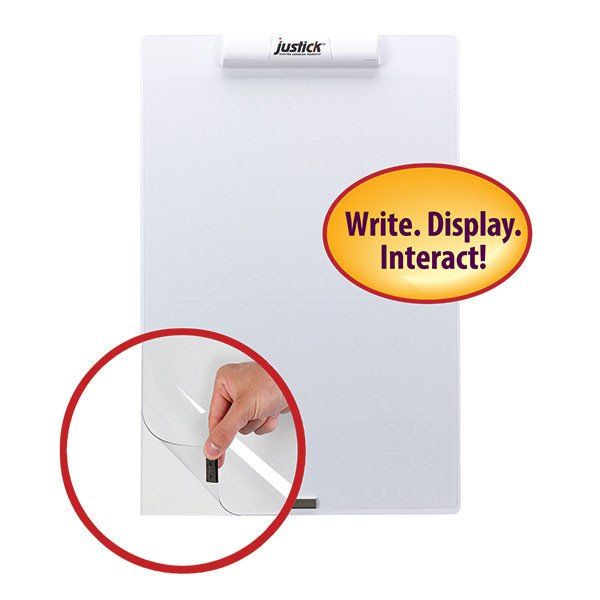
Premium Aluminum Frame Dry-Erase Boards with Clear Overlays
If you want something on a grander scale, for your home, school, business, or medical office, Justick has four full-sized dry-erase options, all with the same electro surface adhesion technology and erasable properties, in either black or white in each of two sizes, measuring 36″ W x 24″ H or 48″ W x 36″ H.
- Premium Aluminum Frame Dry-Erase Board, Black with Clear Overlay, 36″ W x 36″ H ($179.99 at myOrganized.life or Amazon)
- Premium Aluminum Frame Dry-Erase Board, White with Clear Overlay, 36″ W x 36″ H ($179.99 at my Organized.life or, right now, $152.39 at Amazon)
- Premium Aluminum Frame Dry-Erase Board, Black with Clear Overlay, 48″ W x 36″ H ($229.99 at myOrganized.life or Amazon)
- Premium Aluminum Frame Dry-Erase Board, White with Clear Overlay, 48″ W x 36″ H ($229.99 at myOrganized.life or Amazon)
JUSTICK ELECTRO COMMERCIAL COMMUNICATION SOLUTIONS
In addition to home and office bulletin board and dry-erase solutions, Justick also has a line of commercial display products suitable for larger businesses, restaurants, hospitals, non-profits, and other locations.
3-Panel Table-Top Expo Display
Picture yourself at the fanciest, most grown-up version of a science fair and you have some sense of how this Justick 3-Panel Table-Top Expo display works. At 72″ W x 36″ H, it allows you to set up your displays for conferences, expos, and whatever corporate version of Show & Tell at which you need to make a big splash, without fear that breezes, un-sticky sticky tape or lost push-pins will cause trouble. It’s priced at $399.99 at myOrganized.life (or $391.67 at Amazon) and can be carried securely in its own 36″ W x 27″ H nylon carrying bag ($99.99).
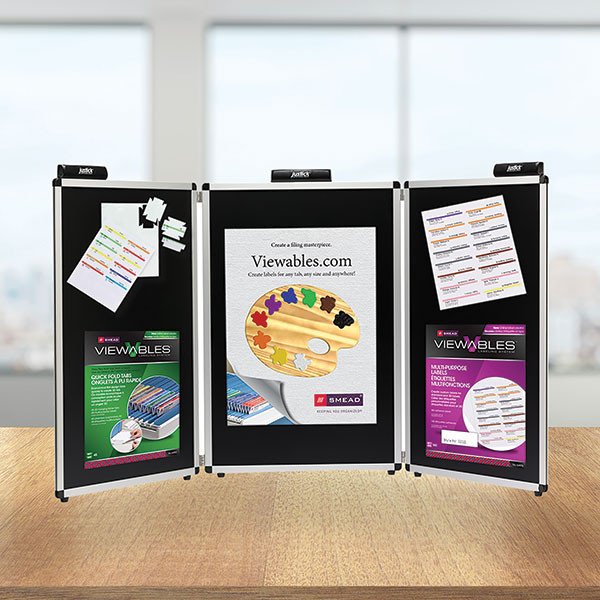
Lobby and Promotional Stands
Justick also makes a wide variety of lobby and promotional stands. They are all black with aluminum frames and have electro surface technology, but you can choose from standard or dry-erase versions for the lobby stands, and choose among single- and double-sided for the promotional stands, as well as a dry-erase version.
- Lobby Stand with Justick Electro Surface Technology, 24″ W x 36″ H ($249.99 at myOrganized.life or Amazon)
- Dry-Erase Lobby Stand with Clear Overlay, 24″ W x 36″ H, with Justick Electro Surface Technology ($299 at myOrganized.life and Amazon)
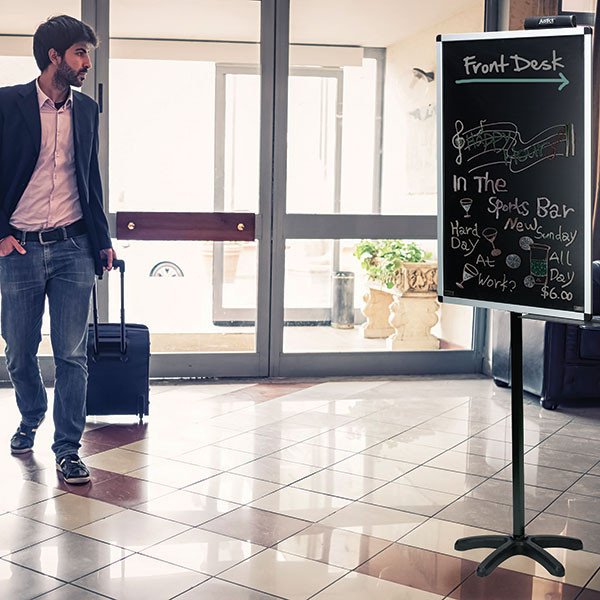
- Promo Stand Single Side, 24″ W x 36″ H, with Justick Electro Surface Technology ($350 at myOrganized.life or $350 at Amazon)
- Promo Stand Double Side, 24″ W x 36″ H, with Justick Electro Surface Technology ($375 at myOrganized.life or Amazon)
- Dry-Erase Promo Stand with Clear Overlay, 24″ W x 36″ H, with Justick Electro Surface Technology ($375 at myOrganized.life or Amazon)

Certainly, some of the higher-end Justick products are more than one would need in a home or small office, and I’d like to see some technology for making the wall-affixed products even easier to display. (Hmm, how about a partnership between Smead’s Justick and 3M’s Command brand of hooks and adhesives?) I’d also love to see some colorful options for the smaller items for use in dorm rooms.
So, why are these Justick products so intriguing?
First, it’s the balloon magic. The ability to make your papers and photos adhere to a vertical surface without having to rummage through your desk for thumbtacks or tape is an organizational advantage.
Second, for the dry-erase versions, it’s advantageous to be able to mix (temporary) storage and dynamic writing.
Third, it’s VERTICAL. As this blog has referenced previously, vertical storage is fabulous when your area is small, when your workspace is awkwardly laid out, and when you want to avoid building up clutter.
- Paper Doll Adjusts the Vertical Hold: Space-Saving File Solutions
- New Smead Organized Up Folders Stand At Attention
- Upright Expansion: Pendaflex® Vertical Reinforced Expanding Wallets and Files
- Up Filer: A New Vertical Filing Solution
- NAPO2014: Our Friends at Smead Are on the Up and Up!
Of course, vertical clutter isn’t completely impossible — I’m sure you’ve seen refrigerator doors with long-forgotten appointment card reminders, overdue notices, and invitations to events that have long-since past — all layered over one another until the door is almost double its original thickness. So, it’s still important to cull and purge your papers on an ongoing basis, whether they’re lying down or standing up.
Don’t you just love balloon magic?
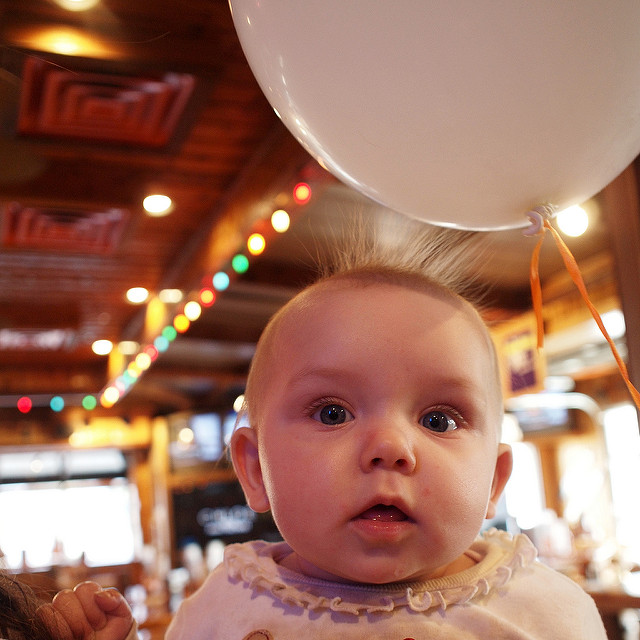
Photo of Bella+Balloon, courtesy of Pat David is licensed under Creative Commons 2.0
Paper Doll’s NAPO 2017 Recap: A Sneak Peak at Smead’s All-in-One® Organizer Kits

Paper Doll doesn’t like to play favorites, but it’s hard not to love a company whose heart and soul is helping you keep your paper organized, so we have more than a few post’s worth of post-NAPO2017 news from our friends at Smead. Today, we’re looking at their direct-to-consumer line, myOrganized.life, designed to help you keep your personal and family documents safe, secure, accessible, and organized. But Smead’s NAPO Expo showing was bountiful, so watch upcoming posts for some nifty innovations.
###
In an emergency, could you find your will? Your Power of Attorney documents? Your life insurance policy? Approaches to general filing systems vary. Some people have very specific, well-labeled, color-coded filing systems that they maintain religiously. Others have one drawer for important documents and one hip-high “stack” earmarked for paid bills, and assuming no strong gust of wind (or a playful puppy or child) gets near, they’re satisfied. Most people, and especially most of my clients, fall somewhere in the middle of the spectrum.
DIY vs. Made-For-You Filing Systems
Often, what holds people back from developing filing systems is perfectionist procrastination. Rather than creating a wrong system, they won’t get started at all. Others, fearful that their system isn’t good enough (measured against some arbitrary benchmark or guideposts), up-end their files and folders and binders, starting from scratch every few months or years, not because their system wasn’t working, but because they’d never committed to it in the first place, and the appeal of a magical solution was more compelling than the reality of having to make decisions and apply rules.
It’s not as though there aren’t multiple ways to contain papers and documents — we have tabbed file folders, hanging folders, ringed binders, accordion-style folders — and they are all fine, depending on your resources, your space, and your willingness to maintain your system. By and large, there is no wrong system — as long as the system works for you!
Longtime readers of this blog know that Paper Doll isn’t going to drink the Koolaid and tell you that you have to buy a pre-existing filing system with pre-made categories, like FreedomFiler. I have many colleagues who love, respect, and recommend that particular pre-made, “self-purging” filing system, with the categories all laid out, and even year/odd year purging and shredding schedules. I see the value, but unless one of my clients asks for something like that during our sessions, it’s my professional experience that people with disorganized (or non-existent) filing systems learn more when, together, we create their entire filing system from scratch. This way, clients learn the why behind the what and the how. I think naming each file something that works for you (Vet: Fluffy vs. Medical: Cat, or Elantra vs. Auto vs. Car vs. Roxanne) helps inspire you to actually file your documents away.
That said, most people don’t have the opportunity (or haven’t taken the opportunity) to work with a professional organizer to get their papers in order, so if people are in a situation where “they don’t know what they don’t know” and don’t have a sense of all the documents they should be creating, collecting, and organizing, a pre-ordained system template can eliminate confusion and stress. For my clients (and readers of this blog), my Family Files approach generally works well as a starting point for getting the whole kit and caboodle in order.
- Family Filing—As easy as (eating) pie
- Financial Filing—Scrapbooking snapshots of your money’s life
- Mom, why is there a receipt stuffed in the turkey?
- I Fought the Law…and the Paperwork Won!
- Patient: “Doctor, it hurts when I do this.” Doctor: “Then don’t do that!”
- Paper Dolls Live In Paper Households
- I Hope Nobody Ever Writes a Nasty Tell-All Called “Paper Doll Dearest”!
It’s one thing to try to finesse an entire system to pay your bills, and track your daughter’s orthodontia plan, and keep your life running, but sometimes, you want to make sure that your super-essential information is available in case of an emergency. Friend-of-the-blog John Hunt, Smead’s Senior Manager of Digital Marketing and host of the Keeping You Organized video podcast, has written previously about the emotional and financial pitfalls of not having essential records available when necessary.
Life Documents Organizer
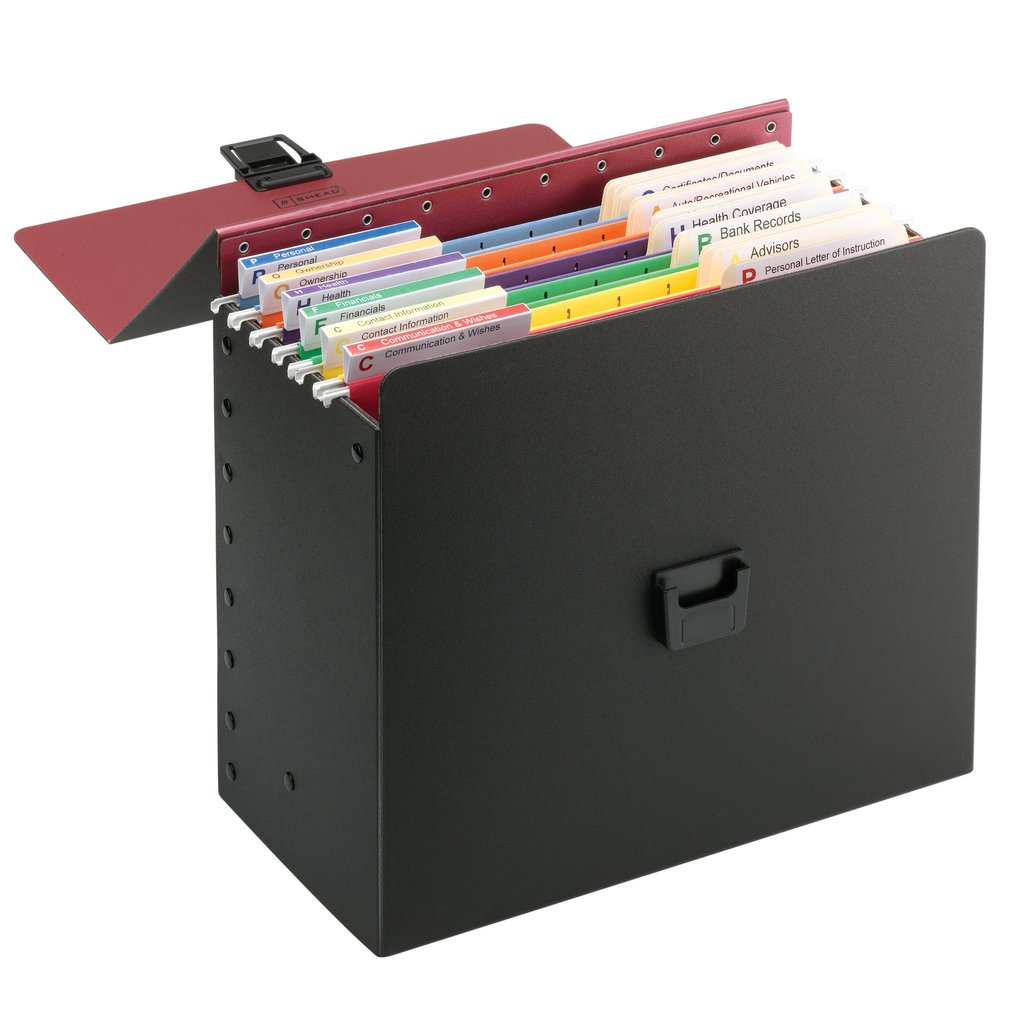
A few years ago, Smead launched its own self-contained filing system called the Life Documents Organizer to help consumers organize and store what they call “key life documents” — what Paper Doll refers to as VIPs (very important papers). These include wills, trusts, health care directives, investment documents, retirement plans, marital and adoption paperwork, and contact information.
Each Life Documents Organizer kit centers around three elements:
- The container — one black polypropylene file box
- The interior essentials — 6 colored hanging folders, 24 SuperTab® file folders, and 1 sheet of Viewables® Quick-Fold tabs, and 3 label sheets with pre-printed labels
- The philosophy — a detailed instruction sheet, based on The Wheel of Organization
Smead’s philosophy behind The Wheel of Organization, and how it’s put into use, is that the hanging folders represent each of six major, overarching “life-essential” categories, and each tabbed folder is used for a document or types of documents in those categories. The kit spells out what those documents are that you should be seeking to plop in there.
The Wheel of Organization includes categories for:
- Financial — essential account information
- Health — medical records and contacts
- Ownership — essentials documents regarding real estate holdings, valuables, insurance, etc.
- Personal — key VIP documents like birth and marriage certificates
- Communication and Wishes — key directive documents and end-of-life instructions
- Contact Information — names and contact information for key advisors
While Paper Doll‘s own Family File categories (financial, legal, medical, household, and personal) are designed to figure in every personal/family document that might be necessary, the Life Documents Organizer kit focuses on just the key documents, the ones that are most likely to be needed in a particular situation, like a healthcare emergency, catastrophic event, or other life-changing circumstance. Smead notes, “Having your key life documents organized helps to ensure that your wishes and assets are managed, retained and distributed as needed while being less stressful for you and your loved ones.”
The Life Documents Organizer Kit runs $39.95 on Amazon and in office supply stores. For more in-depth information, be sure to check out myOrganized.life’s dedicated Life Documents Organizer page.
All-in-One™ Organizing Kits
Sometimes, you want or need your documents to be quickly accessible, portable, and/or self-contained, separate from your regular files. Certainly, you could use a traditional red rope accordion folder, the type attorneys have been using for generations. However, they’re a bit drab and hard to tell one from the other without using a label maker to help identify the contents. This is where the new myOrganized.life line of kits comes in.
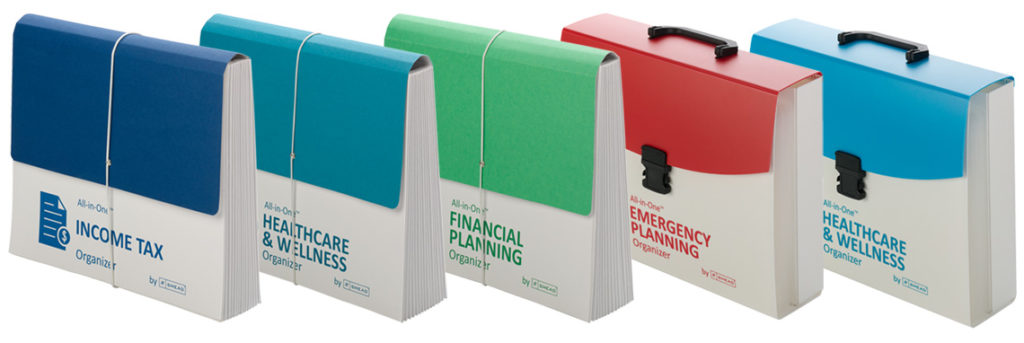
All-in-One™ Emergency Kit

This snappy red-and-white (First Aid-themed) durable poly organizer has 12 interior pockets and includes Viewables® labels. The kit has a plastic handle for portability and a latch closure for security.
All-in-One™ Healthcare & Wellness Organizer
For healthcare, there are two versions of the kit:

The boxier durable poly organizer is identical in design to the Emergency Organizer Kit, but with a soothing blue and white theme, and has a plastic handle and latch closure, 12 interior accordion-style pockets, and Viewables® labels.

For those who prefer paper to poly, there’s a durable paper Healthcare & Wellness accordion version, with an over-the-top paper flap and elastic band closure. There are 12 expandable pockets with one large pocket in back, and it also includes Viewables® labels.
All-in-One™ Financial Planning Organizer
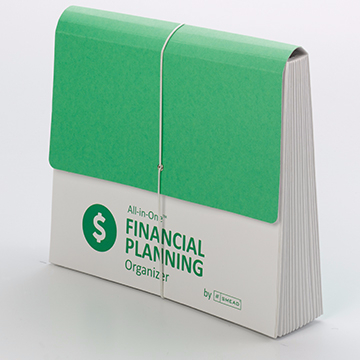
All-in-One™ Income Tax Organizer
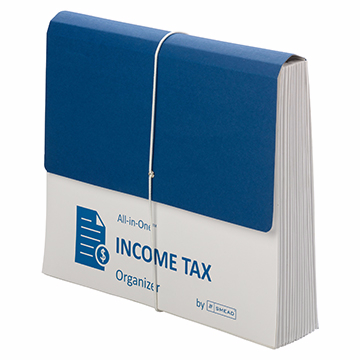
Both the green and white Financial Planning Organizer and the navy blue and white Income Tax Organizer come in the durable paper version, with an over-the-top flap and elastic band closure, 12 expandable pockets with one large pocket in back, and Viewables® labels.
The Financial and Income Tax organizers, as well as the paper Healthcare & Wellness Organizer, contain 10% recycled content and 10% post-consumer material.
The All-in-ONe™ Income Tax Organizer is currently available at Amazon and office supply stores, and runs about $18. The remainder of the All-in-One™ Organizer Kits are branded COMING SOON, so pricing information is not yet available.
Create a DIY Kit With the Smead Poly File Box
Sometimes, you have a clear idea of what you want to create, but you don’t want to have to go in search of putting all the pieces together. I wasn’t surprised to find that myOrganized.life has an option for that, too. You could start with the Smead Poly File Box (suitable for desktop or in-drawer use) and add your own hanging folders and tabbed interior folders, in whatever color schemes you prefer, using whatever labels fit your needs.

It’s a sturdy poly file box and holds up to 3″ of files, directories, or similar materials, and can be used with hanging files and interior folders, or just folders, depending on your needs and preferences. The Smead Poly File Box is harder to find in brick-and-mortar stores than online, and runs from $8.95-$10.55.
Conversely, you could opt for the Poly File Box with SuperTab® Folder and Viewables® Labels Kit.
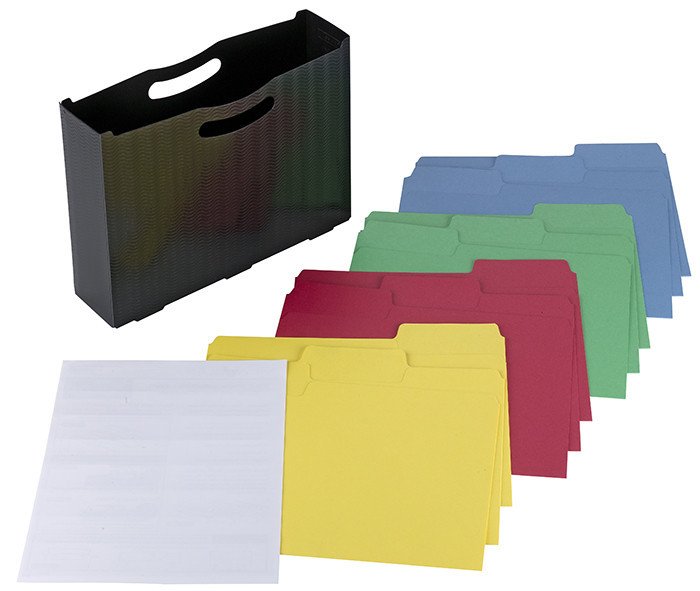
The kit comes with one black poly file box, 12 colored one-third cut SuperTab® file folders (three each of yellow, red, green, and blue) and 16 Viewables® labels. The SuperTab® folders have a 90% larger labeling area than standard folders, so you can use larger text or more lines of description. The file box is lidless, so you’ll want to make sure that if you need it to be portable, you’re holding it securely and upright. The Poly File Box with SuperTab® Folder kit runs upwards from $11.95.
And that’s the straight talk on Smead’s organizer kits. No caboodle!

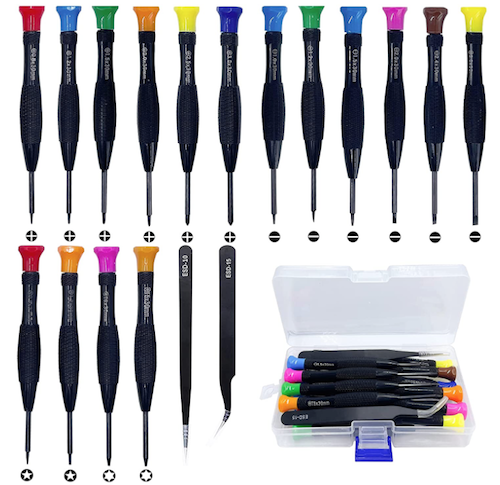
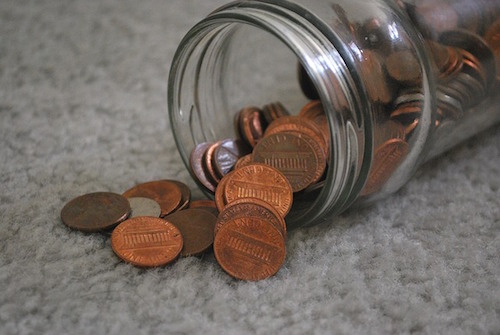
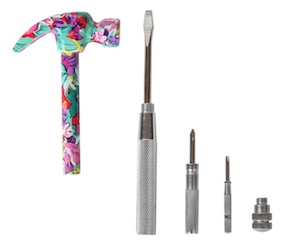





 Mesh desk drawer organizers from office supply stores are usually inexpensive, low-key attractive, and work well when you want to buy just one thing. This
Mesh desk drawer organizers from office supply stores are usually inexpensive, low-key attractive, and work well when you want to buy just one thing. This 

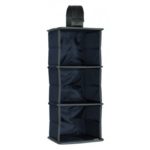
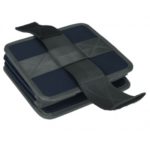
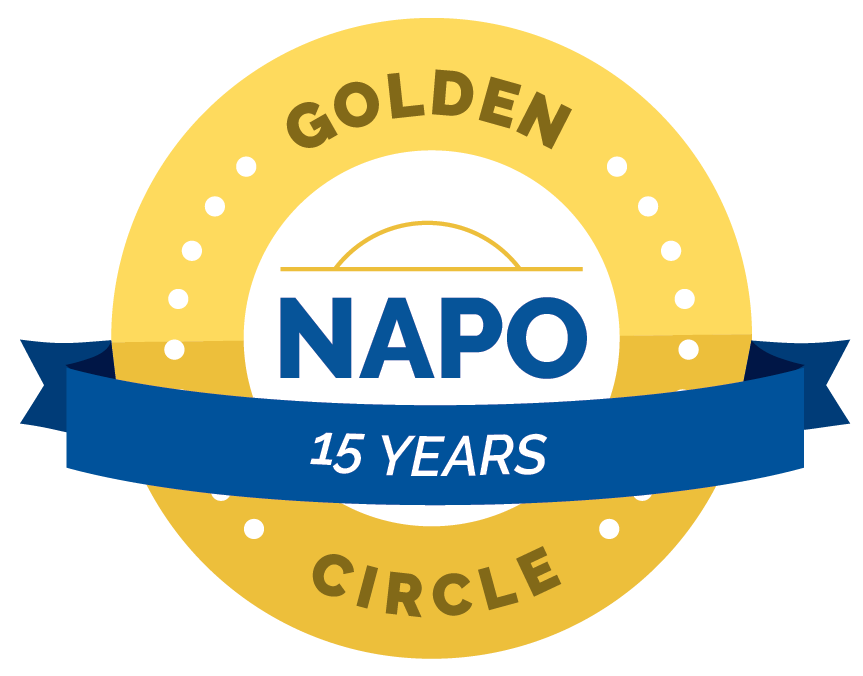


Follow Me